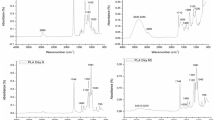Abstract
The degradability of several degradable polymers was examined using three types of degradation environments. These include exposure in a laboratory-scale composting test system containing material representative of the organic fraction of municipal solid waste (MSW), exposure in a thermal hydrolytic environment consisting of water at 60‡C, and exposure in a thermal-oxidative, dry oven environment of 60‡C. The results of the investigation clearly indicate that, in addition to chemical and biological activity which can lead to polymer degradation, physical restructuring and reorganization of the macromolecular structure may also occur at temperatures typically found in a compost environment, resulting in changes in the mechanical properties of the polymer films. In the case of the polyethylene-modified polymers evaluated in this study, all behaved similarly, but differently from the other polymer types. The polyethylene-based films appeared to be susceptible to oxidative degradation and should degrade in a composting environment providing that there is sufficient air in contact with the film for a sufficient period of time. However, when exposed in a laboratory composter, it appears that although ideal temperature-time curves may be obtained, the test time period was insufficient in comparison to the induction period required to achieve the desired thermal oxidative degradation.
Similar content being viewed by others
References
G. Scott (1990)Polym. Degrad. Stab. 29, 135–154.
J. D. Evans and S. K. Sikdar (1990)Chemtech 20(1), 38–42.
M. M. Nir, J. Milty, and A. Ram (1993)Plastics Eng. 393, 75–93.
S. J. Huang (1995)J.M.S. Pure Appl. Chem. A32(A), 593–597.
L. R. Krupp and W. J. Jewell (1992)Environ. Sci. Technol. 26, 193–198.
M. Waland, A. Daro, and C. David (1995)Polym. Degrad. Stab. 48, 275–289.
P. B. Shah, S. Bandopadhyay, and J. R. Bellare (1995)Polym. Degrad. Stab. 47, 165–173.
G. Swift (1995)J.M.S. Pure Appl. Chem. A32(4), 641–651.
R. B. Monk (1994)World Wastes 37(5), CS1–14.
N. Goldstein and R. Steuteville (1994)Biocycle 35(11), 30–35.
U.S. Environmental Protection Agency (1994)Characterization of Municipal Solid Waste in the United States: 1994 Update, EPA-S30-C-95-001, Washington, DC.
G. H. Hyatt (1995)Agricultural Utilization of Urban and Industrial By-Products, ACS Special Publication No. 58.
H. G. Greizerstein, J. A. Syracuse, and P. J. Kostyniak (1993)Polym. Degrad. Stab. 39, 251–259.
J.-D. Gu, S. Coulter, D. Eberiel, S. P. McCarthy, and R.A. Goss (1993)J. Environ. Polym. Degrad. 1(4), 293–299.
J.-D. Gu, D. T. Eberiel, S. P. McCarthy, and R. A. Gross (1993)J. Environ. Polym. Degrad. 1(2), 143–153.
F. Lefebvre, C. David, and C. V. Wawen (1994)Polym. Degrad. Stab. 45, 347–353.
M. Weiland and C. David (1994)Polym. Degrad. Stab. 45, 371–377.
J. Mergaert, C. Anderson, A. Wouters and J. Swings (1994)J. Environ. Polym. Degrad. 2, 177–183.
R. M. Gardner, C. M. Buchanan, R. Komarek, D. Dorschel, C. Boggs, and A. W. White (1994)J. Appl. Polym. Sci. 52, 1477–1488.
J.-D. Gu, S. Yang, R. Welton, D. Eberiel, S. P. McCarthy, and R. A. Gross (1994)J. Environ. Polym. Degrad. 2(2) 129–135.
A. C. Palmisano, D. A. Maruscik, C. J. Ritchie, B. S. Schwab, S. R. Harper, and R. A. Rapaport (1993)J. Microbiol. Methods 18, 99–112.
E. Epstein and J. I. Epstein (1989)BioCycle 30(8), 50–53.
American Society for Testing and Materials (1988) inASTM Book of Standards, Vol. 8.01, pp. 326–334.
Author information
Authors and Affiliations
Additional information
Issued as NRCC No. 37620.
Rights and permissions
About this article
Cite this article
Day, M., Shaw, K., Cooney, D. et al. Degradable polymers: The role of the degradation environment. J Environ Polym Degr 5, 137–151 (1997). https://doi.org/10.1007/BF02763657
Issue Date:
DOI: https://doi.org/10.1007/BF02763657




